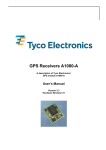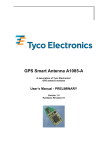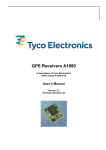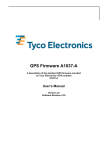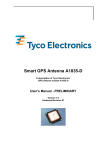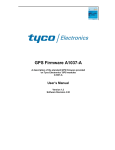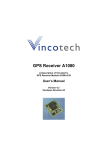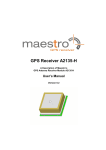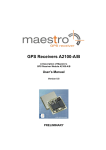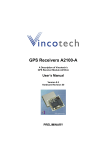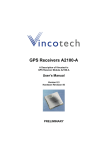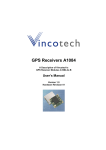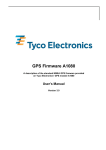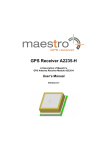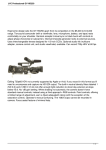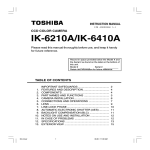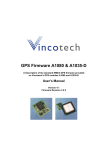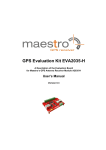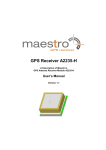Download GPS Receiver A1037
Transcript
GPS Receivers A1037-A A description of Tyco Electronics’ GPS module A1037-A User’s Manual Version 2.0 Hardware Revision 01 This page was intentionally left blank. Revision History Revision History Rev. 1.0 1.1 1.2 Date 11-10-06 08-09-06 09-22-06 1.3 1.4 1.6 2.0 11-28-06 12-08-06 03-14-07 03-20-07 mm-dd-yy V2.0 - 03/07 Description Initial Draft. Final product specification implemented Minor changes (storage temperature, spell check) Packaging details added Additional info “Connection of RF Signal” Application not antenna current limiter Some minor changes New design User’s Manual Page 3 of 29 Disclaimer Disclaimer THIS DOCUMENT CONTAINS PROPRIETARY INFORMATION OF TYCO ELECTRONICS CORPORATION/POWER SYSTEMS (TYCO ELECTRONICS). IT MAY NOT BE COPIED OR TRANSMITTED BY ANY MEANS, PASSED TO OTHERS, OR STORED IN ANY RETRIEVAL SYSTEM OR MEDIA, WITHOUT PRIOR CONSENT OF TYCO ELECTRONICS OR ITS AUTHORIZED AGENTS. THE INFORMATION IN THIS DOCUMENT IS, TO THE BEST OF OUR KNOWLEDGE, ENTIRELY CORRECT. HOWEVER, TYCO ELECTRONICS CAN NEITHER ACCEPT LIABILITY FOR ANY INACCURACIES, OR THE CONSEQUENCES THEREOF, NOR FOR ANY LIABILITY ARISING FROM THE USE OR APPLICATION OF ANY CIRCUIT, PRODUCT, OR EXAMPLE SHOWN IN THE DOCUMENT. THE PRODUCT (HARD- AND SOFTWARE) DESCRIBED IN THIS DOCUMENTATION IS NOT AUTHORIZED FOR USE IN LIFE SUPPORT DEVICES OR SYSTEMS WITHOUT THE EXPRESS WRITTEN APPROVAL OF TYCO ELECTRONICS. THIS DOCUMENT MAY PROVIDE LINKS TO OTHER WORLD WIDE WEB SITES OR RESOURCES. BECAUSE TYCO ELECTRONICS HAS NO CONTROL OVER SUCH SITES AND RESOURCES, TYCO ELECTRONICS SHALL NOT BE RESPONSIBLE FOR THE AVAILABILITY OF SUCH EXTERNAL SITES OR RESOURCES, AND DOES NOT ENDORSE AND IS NOT RESPONSIBLE OR LIABLE FOR ANY CONTENT, ADVERTISING, PRODUCTS, OR OTHER MATERIALS ON OR AVAILABLE FROM SUCH SITES OR RESOURCES. TYCO ELECTRONICS SHALL NOT BE RESPONSIBLE OR LIABLE, DIRECTLY OR INDIRECTLY, FOR ANY DAMAGE OR LOSS CAUSED OR ALLEGED TO BE CAUSED BY OR IN CONNECTION WITH USE OF OR RELIANCE ON ANY SUCH CONTENT, GOODS OR SERVICES AVAILABLE ON OR THROUGH ANY SUCH SITE OR RESOURCE. TYCO ELECTRONICS RESERVES THE RIGHT TO CHANGE, MODIFY, OR IMPROVE THIS DOCUMENT OR THE PRODUCT DESCRIBED HEREIN, AS SEEN FIT BY TYCO ELECTRONICS WITHOUT FURTHER NOTICE. Page 4 of 29 User’s Manual V2.0 - 03/07 Table of Contents Table of Contents 1 Introduction ........................................................................................................ 7 1.1 Label ................................................................................................................. 7 1.2 Characteristics .................................................................................................. 8 1.3 Handling Precautions ........................................................................................ 8 2 Ordering Information ......................................................................................... 9 2.1 GPS Receiver A1037-A .................................................................................... 9 2.2 Packing ............................................................................................................. 9 2.2.1 Packaging of the A1037-A.......................................................................................... 9 2.3 Additional Equipment ...................................................................................... 10 3 Quick Start........................................................................................................ 11 3.1 Minimum Configuration ................................................................................... 11 3.2 Antenna........................................................................................................... 12 3.3 Serial Port Settings ......................................................................................... 12 3.4 Improved TTFF ............................................................................................... 12 4 Mechanical Outline .......................................................................................... 13 4.1 Details Component Side A1037-A................................................................... 13 4.2 Details Solder Side A1037-A........................................................................... 14 5 Pin-out Information .......................................................................................... 15 5.1 Layout A1037-A .............................................................................................. 15 5.2 Description A1037-A Signals .......................................................................... 15 5.3 General Comments ......................................................................................... 16 6 Electrical Characteristics ................................................................................ 17 6.1 Operating Conditions ...................................................................................... 17 6.1.1 Absolute maximum ratings ....................................................................................... 17 7 Mounting........................................................................................................... 18 7.1 Proposed Footprint for Soldering .................................................................... 18 7.2 Recommended Profile for Reflow Soldering ................................................... 18 8 Use of Antenna................................................................................................. 19 8.1 Connection of RF Signal ................................................................................. 19 8.2 Active Antenna ................................................................................................ 20 9 Quality and Reliability...................................................................................... 21 9.1 Environmental Conditions ............................................................................... 21 9.2 Product Qualification ....................................................................................... 21 9.3 Production Test ............................................................................................... 21 10 Applications and Hints .................................................................................. 22 10.1 Minimum Configuration ................................................................................. 22 10.2 Antenna Status Adaptation ........................................................................... 22 10.2.1 Antennas with Different Current Draw .................................................................... 22 10.2.2 Antennas with Different Current Draw incl. Current Limiter.................................... 23 V2.0 - 03/07 User’s Manual Page 5 of 29 Table of Contents 10.3 VANT Pin (antenna voltage input pin) ........................................................... 24 10.4 1PPS pin (1 pulse per second pin)................................................................ 25 10.5 Reset Signal.................................................................................................. 25 10.6 Battery Back-up............................................................................................. 25 11 Demonstration Kits ........................................................................................ 26 11.1 Evaluation Kit A1037-A ................................................................................. 26 12 Related Information ....................................................................................... 27 12.1 Contact.......................................................................................................... 27 12.2 Related Documents....................................................................................... 27 13 List of Tables .................................................................................................. 29 14 List of Figures ................................................................................................ 29 Page 6 of 29 User’s Manual V2.0 - 03/07 GPS Receiver A1037-A 1 Introduction Tyco Electronics’ GPS module A1037-A is a highly integrated GPS receiver module that can be used as an SMT component. It is capable to receive signals from up to 12 GPS satellites and transferring them into position and timing information that can be read over a serial port. This new generation of GPS module combines small size and high-end GPS functionality at low power consumption: • • • • • Operable at 3.3V / 50mA (typ.) @ 1fix per second Small form factor of 19 x 16.2 mm (0.75” x 0.64”) Cost-effective antenna input Single-sided SMD component, for reflow soldering Tape & reel packaging The A1037-A GPS receivers are available as off-the-shelf components, 100% tested and shipped in standard tape-and-reel package. 1.1 Label The A1037-A label holds the following information: Figure 1: A1037-A label V2.0 - 03/07 User’s Manual Page 7 of 29 GPS Receiver A1037-A 1.2 Characteristics The modules are characterized by the following parameters. Channels Frequency Position Accuracy Time To First Fix – TTFF (theoretical minimum values; values in real world may differ) Stand alone Obscuration recovery (1) Hot start (2) Warm (3) Autonomous / cold (4) (5) 12, parallel tracking L1 (= 1575 MHz) 3m CEP (SA off) 1s < 3s < 32s < 60s Table 1: A1037 characteristics (1) (2) (3) (4) (5) The calibrated clock of the receiver has not stopped, thus it knows precise time (to the µs level). The receiver has estimates of time/date/position and valid almanac and ephemeris data. The receiver has estimates of time/date/position and recent almanac. The receiver has no estimate of time/date/position, and no recent almanac. To improve TTFF, the receiver allows setting of time/date, position, almanac and ephemeris A1037-A Mechanical dimensions Length Width Height A1037-A Weight 19mm, 0.75” 16.24mm, 0.64” 2.4mm, 0.095” 1g, < 0.05oz Table 2: A1037-A dimensions and weight 1.3 Handling Precautions The GPS receiver module A1037-A is sensitive to electrostatic discharge (ESD). Please handle with appropriate care. Page 8 of 29 User’s Manual V2.0 - 03/07 GPS Receiver A1037-A 2 Ordering Information 2.1 GPS Receiver A1037-A The order number is built as follows: • V23993A1037A V23993 stands for Tyco Electronics wireless and communication products, A1037A for the A1037-A module. 2.2 Packing 2.2.1 Packaging of the A1037-A The A1037-A GPS module comes in a tape and reel package suitable for pick and place machines. Figure 2: A1037-A tape specifications (1) V2.0 - 03/07 User’s Manual Page 9 of 29 GPS Receiver A1037-A Figure 3: A1037-A tape specifications (2) 2.3 Additional Equipment V23993EVA1037A Evaluation Kit (including one module V23993A1037A) Table 3: Additional equipment A detailed description of the additional kit can be found in the according manuals. Page 10 of 29 User’s Manual V2.0 - 03/07 GPS Receiver A1037-A 3 Quick Start In order to allow an easy and quick start with the modules A1037-A, this chapter provides a short overview on the most important steps to receive NMEA messages with position information on a serial port. 3.1 Minimum Configuration The following picture shows a recommended minimum configuration for NMEA output and commands sent and received via an RS232 interface based on the GPS module A1037-A. Figure 4: Recommended minimum configuration A1037-A Remarks: • Place C2 to C6 close to SP3222. For capacity values see datasheet of actual component used. • Use 3.3V level shifter (SP3222 or equivalent). • Use separate ground plane for antenna ground. • Antenna input impedance is 50Ohm. Match as close as possible. • Maximum allowed antenna current is 50mA. Consider a current limiter. • A battery back-up circuit for the RTC (Real Time Clock) should be considered (see 10.6 Battery Back-up)! NOTE: Please make sure that the A1037-A is either within an enclosure or additionally shielded to reduce the influence of temperature fluctuations often generated by airflow. V2.0 - 03/07 User’s Manual Page 11 of 29 GPS Receiver A1037-A 3.2 Antenna It is recommended to use an active GPS antenna with supply voltage of 3 to 5VDC and a current draw of 50mA maximum. The quality of the GPS antenna chosen is of paramount importance for the overall sensitivity of the GPS system. An active antenna should have a gain ≥ 20dB and a noise figure ≤ 1.5dB, which applies to more than 95% of the active antennas available in the market. 3.3 Serial Port Settings Using Pin P0.13 two different set of GPS NMEA out messages with two different baud rates can be selected. CONF (P0.13) Leave unconnected / External pull-up External pull-down NMEA Messages Set NMEA: GGA – VTG – GSA – GSV Baud rate: 4800 Transmit mode: on UTC second NMEA: GGA – GSA – GSV - RMC – TG –TS - PA Baud rate: 57600 Transmit mode: on UTC second Default X Table 4: NMEA configuration This pin will be read by the software during the GPS software start-up only. Any changes in the setting afterwards will not affect the configuration. The default configuration within the standard GPS firmware is: • Serial 0 (NMEA) 4800 baud, 8 data bits, no parity, 1 stop bit, no flow control 3.4 Improved TTFF In order to improve the TTFF (Time To First Fix), it is recommended to support the RTC with a back-up super-capacitor (“supercap”) or a battery when no system power is available. If the system or the GPS receiver alone should not be backed-up it is possible to support the restart procedure by providing position and date/time information to the module. This is described in the firmware manual. Please refer there to chapter “Start-up Support” in the document T.E. GPS Firmware A1037. Page 12 of 29 User’s Manual V2.0 - 03/07 GPS Receiver A1037-A 4 Mechanical Outline 4.1 Details Component Side A1037-A All dimensions in [mm (inch)] Figure 5: Mechanical outline component side A1037-A V2.0 - 03/07 User’s Manual Page 13 of 29 GPS Receiver A1037-A 4.2 Details Solder Side A1037-A Solder pad size: 1.4 x 0.9 All dimensions in [mm] Figure 6: Mechanical outline solder side A1037-A Page 14 of 29 User’s Manual V2.0 - 03/07 GPS Receiver A1037-A 5 Pin-out Information 5.1 Layout A1037-A Figure 7: Pin-out information A1037-A 5.2 Description A1037-A Signals Pin 1 2 3 4 5 6 7 8 9 10 11 12 Symbol GND Vcc Vbak 1PPS (P1.8) RX1 (P0.10) TX1 (P0.11) TX0 (P0.9) RX0 (P0.8) nRST CONF (P0.13) Res. (P0.14) GNDANT 13 14 ANT GNDANT 15 VANT Description Ground (power supply) 3.3 – 3.6 VDC (power supply) Back-up pin of module for “supercap” or battery (see below) 1PPS (pulse per second) output Serial input 1 – reserved (leave open) Serial output 1 – reserved for debug (leave open) Serial output 0, NMEA out Serial input 0, NMEA in Reset input NMEA configuration - see chapter 3.3 Serial Port Settings Reserved – leave open Antenna Ground, do not connect to GROUND, connect to antenna shield (see below) Antenna signal / Z=50 Ohm Antenna Ground, do not connect to GROUND, connect to antenna shield (see below) Power supply antenna – provide according voltage Table 5: Pin description A1037-A V2.0 - 03/07 User’s Manual Page 15 of 29 GPS Receiver A1037-A 5.3 General Comments The following comments should be considered for a design with and use of the module: • • Standard configuration of serial port (standard GPS software): Serial 0 (NMEA) 4800 baud, 8 data bits, no parity, 1 stop bit, no flow control Antenna (Antenna connected to Antenna Pin) Use ground pins (pin 12, pin 14) close to the antenna input for RF ground. Page 16 of 29 User’s Manual V2.0 - 03/07 GPS Receiver A1037-A 6 Electrical Characteristics 6.1 Operating Conditions Pin 2 4 15 13 Description Vcc Current draw (without active antenna) Input current in standby mode typical value at 20°C max. value at min. temperature 1PPS (1 pulse per second), reference GPS time VANT (active antenna supply voltage) Antenna current ANT (antenna pin) Output pins VOH VOL Input pins VIH VIL Min 3.3V Typical 3.3V 54mA Max 3.6V 20µA 20µA 300µA +120ns 0V 5.5V 50mA Z0=50Ω Vcc0.8V 0.4V 2.0V 0.8V Table 6: Operating Conditions 6.2 Absolute maximum ratings Symbol Vcc Vin Iov Itdv Tst Vant Parameter Power supply Voltage to any pin Input current on any pin Absolute sum of all input currents during overload condition Storage temperature Antenna power supply Min -0.3 -0.3 -10 -40 0 Max Unit +3.6 V +3.6 V 10 mA 200 mA 125 °C 5.5 V Table 7: Absolute maximum ratings Stresses beyond those listed under “Absolute Maximum Ratings” may cause permanent damage to the device. This is a stress rating only. Functional operation of the device at these or any other conditions beyond those indicated in the operational sections of this specification is not implied. Exposure to absolute maximum rating conditions for extended periods may affect device reliability. V2.0 - 03/07 User’s Manual Page 17 of 29 GPS Receiver A1037-A 7 Mounting This chapter covers the mounting of the A1037-A. 7.1 Proposed Footprint for Soldering The following proposal of a footprint for soldering is assuming a stencil thickness of 150µm. ³ marks the center of the through holes. Figure 8: Soldering footprint proposal A1037-A Please note that copper and solder paste footprint are identical. The final footprint has to be evaluated and qualified by the manufacturer according to the specific processes. 7.2 Recommended Profile for Reflow Soldering Typical values for reflow soldering of the module in convection or IR/convection ovens are as follows: Peak temperature Average ramp up rate to Peak (183°C to Peak) Preheat temperature 125 (±25°C) Temperature maintained above 183°C Time within 5°C of actual peak temperature Ramp Down rate Time 25°C to peak temperature 245°C 3°C / second max. 120 seconds max. 60 … 150 seconds 10 … 20 seconds 6°C / second max. 6 minutes max. Table 8: Reflow soldering profile A1037-A As results of soldering may vary among different soldering systems and types of solder and depend on additional factors like density and types of components on board, the values above should be considered as a starting point for further optimization. Page 18 of 29 User’s Manual V2.0 - 03/07 GPS Receiver A1037-A 8 Use of Antenna 8.1 Connection of RF Signal The ANT pin is used to connect the receiver with the GPS antenna. The design of the antenna connection has to be done strictly according to RF design rules. A 50Ω PCB strip line is required. The following drawings shall explain the guidelines. A major rule is to keep the strip line as short as possible. Additionally, antenna ground (GNDANT) should be routed to the ground plane of the PCB (the ground plane is on a lower PCB layer) by via as demonstrated in the drawing. Figure 9: Antenna connector strip line A1037-A In order to gain the impedance of 50Ω, the width of the strip line needs to be calculated. It depends on the thickness or height of the PCB layer (both parameters are shown in following drawing). For our calculation, we assume that the PCB material is FR4. Figure 10: Strip line parameters A1037-A In this case, the width should be about 1.8 times the height of the PCB: W = 1.8 x H In our example, we would get a width of W = 1.8 x 0.8mm = 1.44mm. V2.0 - 03/07 User’s Manual Page 19 of 29 GPS Receiver A1037-A 8.2 Active Antenna General GPS active antenna specification: Limitations: • • Supply voltage according to voltage fed into VANT pin (5V max.) Supply current 50mA (max.) Recommendations: • • Gain ≥ 20dB (should not exceed 35dB) Noise figure ≤ 1.5dB The recommendations apply to the majority of active antennas that can be found in the market. Anyhow, the quality of the GPS antenna chosen is of paramount importance for the overall sensitivity of the GPS system. The system design needs to reflect the supply voltage of the antenna. If the supply voltage is equal to Vcc, Vcc can be connected to VANT. If the antenna requires a different supply voltage, the antenna bias can be provided through the VANT pin. Page 20 of 29 User’s Manual V2.0 - 03/07 GPS Receiver A1037-A 9 Quality and Reliability 9.1 Environmental Conditions Operating temperature Operating humidity MSL JEDEC (Moisture Sensitivity Level) Storage -30 … +70°C Max. 85% r. H., non-condensing, at 85°C 3 6 months in original package. Table 9: Environmental conditions 9.2 Product Qualification Prior to product qualification the GPS receiver is preconditioned according to EIA/JEDEC standard JESD22-A113-B / Level 3. Basic qualification tests: • • • • • • • • MSL Classification according to J-STD-020C (MSL3 @ 245°C) MSL Rework Compatibility according to J-STD-020C Temperature Cycling –30°C … +70°C Temperature Humidity Bias 70°C / 85% RH High / Low Temperature Operating –30° / +70°C High Temperature Operating Life +70°C Vibration Variable Frequency Mechanical Shock Please contact Tyco Electronics for detailed information. 9.3 Production Test Each module is electrically tested prior to packing and shipping to ensure state of the art GPS receiver performance and accuracy. V2.0 - 03/07 User’s Manual Page 21 of 29 GPS Receiver A1037-A 10 Applications and Hints 10.1 Minimum Configuration Please refer to chapter 3.1 Minimum Configuration for details. In addition, for optimized start-up behavior it is strongly recommended to add a battery back-up circuit (see chapter 3.4)! 10.2 Antenna Status Adaptation This chapter shall give assistance in designing a circuit for detecting if an antenna is connected to the module. The information about the antenna status can be derived from the ANTSTAT signal generated by this circuit. The examples use values for components that roughly result in the following ANTSTAT output: • • • Logic low when: Logic high when: Logic low when: Iant < 9mA 9mA > Iant < 16mA Iant > 16mA 10.2.1 Antennas with Different Current Draw The following circuit is a proposal on how you can feed an antenna with 3.3V and provide an output for the ANTSTAT pin. The value of the components may need an adaptation in the final application. For example, the input current of the chosen comperator goes into that equation. The thresholds defined in this circuit are quite close to the ones described above. Their value is determined by resistors R4, R5, and R3. We strongly recommend simulating and testing your realized version before using it. In any case, it is the responsibility of the designer to test and verify the implementation. Page 22 of 29 User’s Manual V2.0 - 03/07 GPS Receiver A1037-A Figure 11: Application note: Antenna sensor adaptation 10.2.2 Antennas with Different Current Draw incl. Current Limiter This proposal is similar to the first one, but includes a current limiter. Comments and notes as above apply. We strongly recommend simulating and testing your realized version before use. In any case it is the responsibility of the designer to test and verify the implementation. Figure 12: Application note: Antenna sensor adaptation with current limiter V2.0 - 03/07 User’s Manual Page 23 of 29 GPS Receiver A1037-A 10.3 VANT Pin (antenna voltage input pin) The VANT pin is an input pin. The supply voltage for an active GPS antenna has to be fed into the Vant pin. The easiest way to do that is to connect Vcc to VANT. The maximum current is 50mA. Note: Shortcut between ANT and GND may damage the A1037-A GPS receiver module. This should be avoided by using an antenna current limiter. Please find proposal for simple current limiter below. If other transistors are used, other resistor values may be necessary as well. We strongly recommend simulating and testing your realized version before using it. The little schematics below work for Vcc from 3V to 5V. The antenna current will be limited to around 50mA. Figure 13: Application note: Antenna current limiter Page 24 of 29 User’s Manual V2.0 - 03/07 GPS Receiver A1037-A 10.4 1PPS pin (1 pulse per second pin) The 1PPS pin is an output pin. In addition to precise positioning, GPS also allows for accurate timing due to the synchronized atomic clocks in the GPS satellites. While the current date and time is transmitted in NMEA sentences, an exact and accurate timing signal is provided via the 1PPS pin of the A1037 modules. 10.5 Reset Signal The nRST pin is an input pin. The nRST pin can be used to generate a reset on the A1037-A module. Resetting the module will result in a restart of the complete firmware. All information stored in SRAM will still be valid. 10.6 Battery Back-up This application note describes on how to back-up the RTC and the SRAM of the GPS receiver module. The basic of the first examples is to provide a back-up by a separate battery or a “supercap”. Here it has to be considered that the RTC is only backed as long as the voltage on the Vbak pin is higher than 2.9V. While the “supercap” is charged thru the module during normal operation, the battery (primary cell) is decoupled thru a diode! Figure 14: Application note: Module back-up An alternative to this solution is to switch the supply voltage from the Vcc pin to the Vbak pin. Care needs to be taken that the there is no voltage outage during the switch-over phase! V2.0 - 03/07 User’s Manual Page 25 of 29 GPS Receiver A1037-A 11 Demonstration Kits 11.1 Evaluation Kit A1037-A For demonstration and easy evaluation of GPS performance Tyco Electronics offers a Demonstration Kit (including one GPS A1037-A module). It contains a USB interface with according drivers to connect easily to a PC. The USB interface is an extension of the serial port 0, therefore sending NMEA sentences and accepting commands. At the same time it provides power to the module. Accompanied by an antenna it offers a ready-to-go set. For the development of new software and applications the Evaluation Kit also provides NMEA messages on C-MOS level via a terminal plug. For further information please contact Tyco Electronics. Page 26 of 29 User’s Manual V2.0 - 03/07 GPS Receiver A1037-A 12 Related Information 12.1 Contact This manual was created with due diligence. We hope that it will be helpful to the user to get the most out of the GPS module. Anyway, inputs about errors or mistakable verbalizations and comments or proposals to TYCO Electronics, Power Systems in Munich, Germany, for further improvements are highly appreciated. Tyco Electronics Power Systems Tyco Electronics Corporation Power Systems Finsinger Feld 1 85521 Ottobrunn, Germany Tel.: +49 89 6089 838 Fax: +49 89 6089 835 [email protected]. www.tycoelectronics.com/gps. Further contact addresses: [email protected]. [email protected]. [email protected]. 12.2 Related Documents • • Manual: T.E. GPS Firmware A1037-A (TYCO) Manual: T.E. GPS Evaluation Kit EVA1037-A (TYCO) V2.0 - 03/07 User’s Manual Page 27 of 29 GPS Receiver A1037-A This page was intentionally left blank. Page 28 of 29 User’s Manual V2.0 - 03/07 Lists of Tables and Figures 13 List of Tables Table 1: A1037 characteristics................................................................................. 8 Table 2: A1037-A dimensions and weight................................................................ 8 Table 3: Additional equipment................................................................................ 10 Table 4: NMEA configuration ................................................................................. 12 Table 5: Pin description A1037-C .......................................................................... 15 Table 6: Operating Conditions ............................................................................... 17 Table 7: Absolute maximum ratings ....................................................................... 17 Table 8: Reflow soldering profile A1037-A ............................................................. 18 Table 9: Environmental conditions ......................................................................... 21 14 List of Figures Figure 1: A1037-A label ........................................................................................... 7 Figure 2: A1037-A tape specifications (1) ................................................................ 9 Figure 3: A1037-A tape specifications (2) .............................................................. 10 Figure 4: Recommended minimum configuration A1037-A.................................... 11 Figure 5: Mechanical outline component side A1037-A ......................................... 13 Figure 6: Mechanical outline solder side A1037-A ................................................. 14 Figure 7: Pin-out information A1037-A ................................................................... 15 Figure 8: Soldering footprint proposal A1037-A ..................................................... 18 Figure 9: Antenna connector strip line A1037-A..................................................... 19 Figure 10: Strip line parameters A1037-A .............................................................. 19 Figure 11: Application note: Antenna sensor adaptation........................................ 23 Figure 12: Application note: Antenna sensor adaptation with current limiter.......... 23 Figure 13: Application note: Antenna current limiter .............................................. 24 Figure 14: Application note: Module back-up ......................................................... 25 V2.0 - 03/07 User’s Manual Page 29 of 29





























